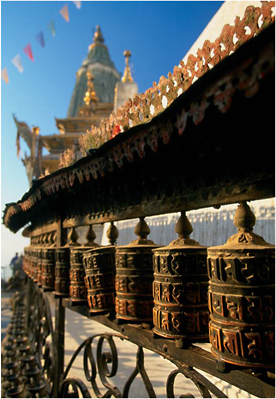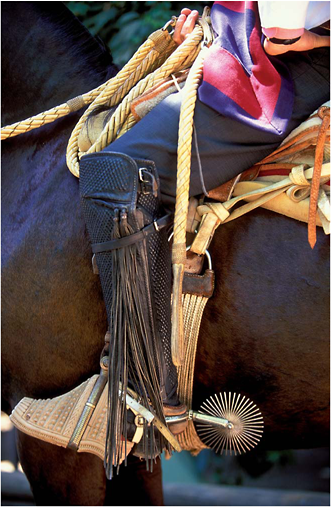Shapes
Point and shoot – that’s how most pictures are taken. Look, raise your camera, point and shoot. What could be simpler? But we all know the difference between a grab shot and a striking image is down to the composition. Given that you’re in the right place at the right time, the arty bit is often how the picture is composed. An eye for the arrangement of shapes within a frame is one of the differences between the taking and making of a photograph.
Composition, or more simply where to point the camera, is all about arranging shapes in the frame. Our first natural instinct is to put the main object of interest in the centre, point and shoot, but a bit of thought about how to frame a picture can transform a snap into a work of art. The simple expediency of moving the main subject away from the centre of the frame can have a dramatic effect on the impact of an image.
The Golden Rule of Thirds is a compositional tool that has guided artists for centuries, possibly millennia, maybe ever since man daubed pictures on cave walls. If the area of a picture is divided up into thirds, then strong lines within the composition – such as the horizon or a prominent tree – will

Prayer wheels at Swayambhunath Temple, Kathmandu, Nepal
The first direct rays of the day eventually penetrate the haze sitting over Kathmandu, lighting up the temple of Swayambhunath on the hill above. It’s my last day in Nepal and I’m trying to squeeze out a few more shots from what has been a magical trip to the Himalayan Kingdom. The country is rapidly descending into chaos, strife and guerrilla warfare but for now all is peace and Buddhist harmony as monks circulate, chanting and spinning the prayer wheels in the crisp dawn light. The intricately carved wheels and the woodwork lead into the shot, and I drop the background slightly out of focus to give a sense of place without detracting from the foreground. The vertical line of the temple is about one-third in and the line of wheels one-third up, but it’s not a conscious decision to use the Golden Rule, more often than not it comes naturally because it just looks right.
“The best compositions are always the simplest; there should be nothing in the frame that doesn’t deserve to be there”

Pont Alexandre III, Hôtel des Invalides and the River Seine at night, Paris, France
I’m standing waiting for the lights to come on, shuffling from foot to foot in the cold winter wind blowing along the River Seine. There’s always this dead time of about an hour to wait after dusk before it’s dark enough to make a night image but at least I’ve had plenty of time to compose this shot. With the Pont Alexandre III leading into the frame towards the Hôtel des Invalides it’s a classic adherence to the Golden Rule of Thirds. The two lines of the embankment and the tops of the row of lights on the bridge and Les Invalides bisect the image area by a third horizontally, while the two towers at the end of the bridge roughly do the same vertically. It’s not an exact science and there are discrepancies, but as a rule of thumb for how to piece together a composition it takes some beating. Eventually the lights come on and the sky darkens enough for me make this exposure and head for warmth. Paris is surely the most beautifully lit city at night.
• Fuji GX617, 180mm lens
give the most pleasing arrangement if they are positioned along one of those lines of thirds. It’s a technique that is unfailingly useful, to such an extent that most painters and photographers, indeed all artists, have developed it as a subconscious compositional default setting. Instinctively I will position elements within a frame along the lines of thirds without ever thinking about it; in fact to do otherwise takes a conscious decision to override the Golden Rule.
It is unarguably true that photography is the art of knowing what to leave out. My mother-in-law (bless her) when taking a snap usually moves back into the adjacent county in order to ‘get it all in’. The result is acres of dead area as foreground and a mass of confusion (the family) in the middle distance. The best compositions are always the simplest; there should be nothing in the frame that doesn’t deserve to be there. Confusing detail in the background kills a shot. Get it out; drop it out of focus, move, change composition, bend your knees or climb a tree, do whatever it takes. Sweep your eye from corner to corner of the frame and consider every element in the shot, how can the composition be improved, is there anything in the shot that shouldn’t be? Be bold, be experimental, be arty, get high, or get low, whatever will make for a bolder composition.

Detail of saddlery of a huaso (Chilean cowboy) at rodeo, San Fernando, Central Valley, Chile
Sometimes composing an image has to be a lightning fast decision based on intuition. At a rodeo in Chile’s Central Valley I’m circulating amongst the huasos waiting their turn to tame a calf in the dusty ring. I know the sort of shot I want - highlighting the intricacies and elaborate craftsmanship of their equipment – but inevitably when the moment comes it’s fleeting. I arrange the strong shapes in the frame, sweep my eye from corner to corner of the eyepiece and shoot a frame, adjust the framing slightly, check focus, and expose two more frames before the huaso spurs his mount into action.
• Nikon F5, 70–200 lens
A feel for composition is all about the positioning of strong shapes in relation to one another. As such I don’t believe it can be taught; to me it’s pretty much instinctive. Ask why I’ve placed that rock in the foreground in that corner of the frame and I can’t explain, it’s just a matter of harmony. It’s another skill to be developed and kept in your toolbox to be used in tandem with all the others as part of the photographer’s vision that starts to create a photograph before a camera is even touched.

Derwentwater at dawn, Lake District, Cumbria, England
Dawn seeps through the sky, reflecting in the still waters. All is calm, tranquil and ethereal. I live for moments like this. I’ve been standing by the tripod on the end of the pier, watching as the darkness breaks, waiting for the light. As the flame red spreads through the sky from the east I take an exposure reading and start to expose. All rules are made to be broken, and here I’m deliberately flouting the Golden Rule of Thirds by placing the pier slap bang in the middle of the frame. Usually that’s a definite no-no but the lines leading into the frame here are so strong it just has to be done. Images such as these, evoking powerful concepts for the viewer to connect with, are always winners. I do believe pictures can be over analysed but it wouldn’t take a huge leap of imagination to connect this one with thoughts of departure, discovery and new beginnings. I am paying lip service to the Golden Rule with the water line being one-third down the frame. Crucially there’s nothing anywhere in the frame that distracts from the simple lines of the composition.
• Fuji GX617, 90mm lens